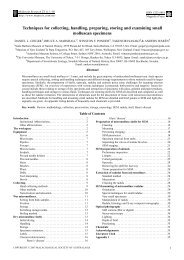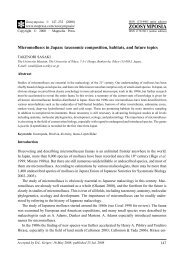Molluscs from Hydrothermal Vents and Cold Seeps in Japan: A ...
Molluscs from Hydrothermal Vents and Cold Seeps in Japan: A ...
Molluscs from Hydrothermal Vents and Cold Seeps in Japan: A ...
You also want an ePaper? Increase the reach of your titles
YUMPU automatically turns print PDFs into web optimized ePapers that Google loves.
126T. Sasaki, T. Okutani & K. Fujikuracommunities <strong>in</strong> any locality <strong>in</strong> the world.4) Heterodonta: Heterodonta is the largest bivalve taxon <strong>in</strong> terms of the number of families<strong>and</strong> species. However, their occurrence <strong>in</strong> vents <strong>and</strong> seeps is strictly restricted to the Luc<strong>in</strong>idae,Thyasiridae <strong>and</strong> Vesicomyidae, many species of which are known to have symbiotic bacteria.The Luc<strong>in</strong>idae are symbiotic with sulfide-oxydiz<strong>in</strong>g bacteria (Taylor & Glover, 2000; Williamset al., 2004). However, their occurrence is considerably limited <strong>in</strong> the vents/seeps of the world(Glover et al., 2004; Salas & Woodside, 2002). So far only two species, Mesol<strong>in</strong>ga soliditesta <strong>and</strong>Luc<strong>in</strong>oma yoshidai, represent records of the family <strong>from</strong> seeps <strong>in</strong> <strong>Japan</strong>.Some members of the Thyasiridae are also known to harbor symbiotic bacteria <strong>in</strong>side (Williamset al., 2004). As <strong>in</strong> luc<strong>in</strong>ids, most species are described <strong>from</strong> areas outside vents <strong>and</strong> seeps (e.g.Oliver & Killeen, 2002). In <strong>Japan</strong>, only two out of 26 species (cf. Higo et al., 1999: B619-B640)<strong>in</strong>habit seeps.An extraord<strong>in</strong>arily huge species for the family, Conchocele bisecta (Conrad, 1849), hasbeen reported to occur <strong>in</strong> cold seeps <strong>in</strong> Sagami Bay (Fujikura et al., 2002b: 24) <strong>and</strong> <strong>in</strong> the Seaof Okhotsk <strong>in</strong> Russia (Kamenev et al. 2001; Sahl<strong>in</strong>g et al., 2003). In <strong>Japan</strong>, more localities arerecorded <strong>in</strong> literature: Tosa Bay, off Tajima, Hyogo Prefecture, <strong>and</strong> off Cape Erimo (Higo et al.,1999: B619), but the environments of these habitats have not been described. This implies thatthere are more unexplored seep sites around <strong>Japan</strong>. In fossil records, C. bisecta has been reported<strong>from</strong> an autochthonous cold-seep assemblage by Kitazaki & Majima (2003) <strong>and</strong> Nobuhara (2003).The Vesicomyidae is the most prom<strong>in</strong>ent faunal element <strong>in</strong> <strong>Japan</strong>ese chemosyntheticcommunities. As listed above, 13 species have been described <strong>from</strong> <strong>Japan</strong>. As <strong>in</strong> Bathymodiolus,some species of Calyptogena are liv<strong>in</strong>g <strong>in</strong> both vents <strong>and</strong> seeps.The systematics of the <strong>Japan</strong>ese Calyptogena have been repeatedly revised by the secondauthor <strong>and</strong> are rather well established (see Okutani et al., 2000a for the latest review). However,there are two species excluded <strong>from</strong> above list, <strong>and</strong> they need some comment.Calyptogena pacifica Dall, 1891 was reported <strong>from</strong> the Sea of Okhotsk by Tiba (1972).The identification of the illustrated specimen by Tiba (1972) is supported by the presence of alarge posterior lateral tooth, which is dist<strong>in</strong>ctive of the species (also cf. Coan et al., 2000: 341).Although Okutani (2000: 997) illustrated this species <strong>and</strong> <strong>in</strong>cluded Hokkaido <strong>in</strong> its distribution,there is actually no reliable record of liv<strong>in</strong>g specimens with<strong>in</strong> <strong>Japan</strong>. Therefore, we elim<strong>in</strong>atedthe species <strong>from</strong> the above list (for fossil records see Kanno et al., 1989; Amano & Kanno, 2005;Majima et al., 2005).The habitat of Calyptogena kawamurai (Kuroda, 1943) is still unknown, although muchattention has been paid to this species. This species has not once been collected <strong>in</strong> dives byJAMSTEC over a period of twenty years. The holotype (Fig. 10) is the only known specimen<strong>from</strong> off Odawara, Sagami Bay (the type locality), but its environment is uncerta<strong>in</strong>. The specimenreported by Tsuchida (1986) <strong>from</strong> the Kii Channel is extremely old <strong>and</strong> possibly derived <strong>from</strong> therema<strong>in</strong>s of an ext<strong>in</strong>ct population. Live specimens were reported <strong>from</strong> off Choshi, the sea area ofKashima-Nada, by Ozaki (1958) <strong>and</strong> Shikama (1962), but their environmental condition has notbeen known. In paleontological studies, C. kawamurai was reported to have occurred <strong>in</strong> fossilcold-seep communities (Nobuhara, 2003).5) Anomalodesmata: It is <strong>in</strong>terest<strong>in</strong>g that no anomalodesmatans successfully colonize deepseachomosynthetic communities, although they are not uncommon <strong>in</strong> general deep-sea muddybottoms. In particular, some major groups that characterize a deep-sea fauna (e.g., Cuspidariidae,Verticordiidae, <strong>and</strong> Poromyidae: Knudsen, 1970, 1979) are entirely miss<strong>in</strong>g. The absence ofAnomalodesmata <strong>and</strong> Protobranchia (except Solemyoida) is one of the prom<strong>in</strong>ent characteristicsof deep-sea hydrothermal vents <strong>and</strong> cold seeps.Scaphopoda: Scaphopods are universally common faunal elements of ‘normal’ nonchemosysnthesis-baseddeep-sea muddy bottoms at bathyal depths (Reynolds, 2002: 204-207).




